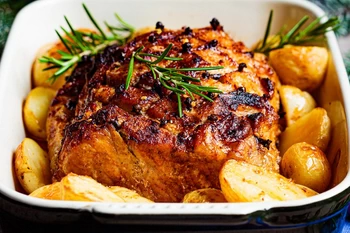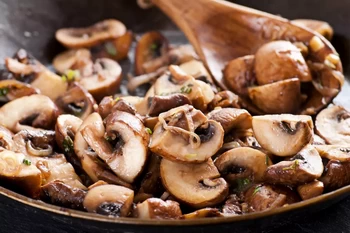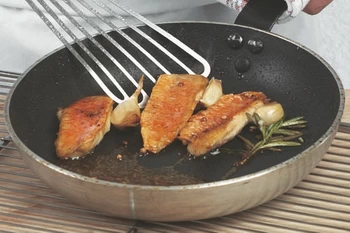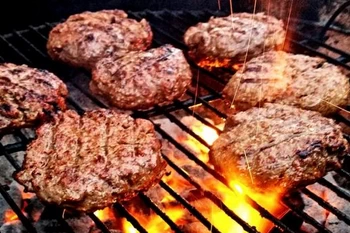The different cooking modes
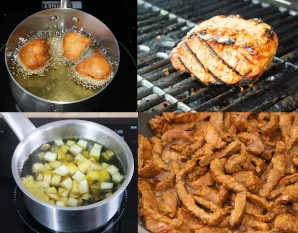
In cooking, cooking means bringing food into contact with a source of heat, to transform it: improving its taste, and sometimes its texture.
This contact with the heat source can be achieved in a number of ways: these are the cooking methods, and let's take a look at the main ones.
This contact with the heat source can be achieved in a number of ways: these are the cooking methods, and let's take a look at the main ones.
9,013 4.7/5 (24 reviews)
Keywords for this post:CookingFashionLexiconRoastPanBraiseSautéFryPoachLast modified on: July 24th 2024
The different cooking modes
Roasting |
| This means cooking, generally in an oven or on a spit, in a dry atmosphere (no steam). The aim is to obtain a nice brown color, a crust on the surface of the food, and a softness inside. Examples: Pork or veal roast |
Sautéing |
| Depending on its size, the food is cut into small pieces, then cooked quickly, uncovered and over high heat, with a small amount of fat, in a very hot saucepan, frying pan or sauté pan. Examples: Sautéed beef, vegetables or mushrooms. |
Pan-frying |
| Frying means cooking the whole food (or a small portion of it) in a pan over medium heat, covered or uncovered. Examples: Pan-fried fillet of sole or red mullet. |
Grilling |
| Quickly cooking food by placing it in direct contact with a heat source or a very hot surface: grill, barbecue coals, plancha. Examples: Barbecued steaks or burgers. |
Frying |
| Cooking food by plunging it directly into a fatty substance (oil, beef fat, etc.). Examples: French fries, fritters. |
Poaching |
| To cook a food by dipping it in an aromatic liquid (stock, juice, fumet, etc.). Examples: Poached pears, fish quenelles. |
Braise |
| The food, generally a whole piece (meat or other), is first seared on each side in a pan with a little very hot fat, then cooked slowly in a closed container that contains a base of liquid, often wine, but not completely immersed in it. Example: Braised beef with red wine and mushrooms. |
These are just the main cooking methods; professional chefs use others, which are often variations of these.
Source: "La cuisine professionnelle" by Yannick Masson and Jean-Luc Danjou.
Lasts posts
Butter vs. grease
We often read in a recipe where a pastry is put into a mould that, just before pouring, the mould should be buttered or greased. But what's the difference between these 2 terms?December 1st 20251,5135
Getting out of the fridge early
Very often when you're cooking, you need to take food or preparations out of the fridge, to use them in the recipe in progress. There's nothing tricky about this: you just take them out of the fridge and use them, usually immediately, in the recipe. But is this really a good method?November 24th 20251,2915
Who's making the croissants?
When you look at a bakery from the outside, you naturally think that in the bakery, the bakers make the bread, and in the laboratory, the pastry chefs make the cakes. It's very often like that, with each of these professions having quite different ways of working, but sometimes there's also one...November 23th 20251,182
Oven height
When we put a dish or cake in the oven, we naturally tend to put it on the middle shelf, and that's what we usually do. But in some cases, this position and height can be a little tricky, so let's find out why.October 8th 20253,3595
The importance of sieving
In recipes that use a fine powder (flour, powdered sugar, etc.), you'll often see the advice to sift before using it. To sift is to pass the powder in question through a sieve (a very fine strainer) before incorporating it into your recipe. It's often advice, but is it really useful?September 3rd 20257,9623
Other pages you may also like
Should I believe my oven?
Can you really trust your oven? This is an important question as we are always tempted to take the temperature indicated as gospel truth and, unfortunately, this is rarely very precise. .July 4th 201133 K4.6
How to zest a fruit?
You will have no doubt noticed that many recipes call for the zest of citrus fruit. The zest is that outer layer of the skin which adds so much flavour to a dish. There are many different ways to peel off the zest and various tools are available. Here is a summary of the “dos and don'ts” of...November 5th 201347 K3.8
Steam for baking bread
What does steam have to do with bread-making? This is not only a bakers' secret, it is something you might not think of at all: if you make bread and bake it like a cake, you will end up with bread, but pale and with a thick, hard crust – a long way from the golden-brown crusty loaf you had in...June 16th 2021147 K4.5
The beautiful story of the croissants
As you may have already noticed, cooking, baking and pastry-making are full of stories or legends, usually very romantic, about this or that product or recipe. This is often the case for named recipes, for example tarte tatin, peach melba, paris-brest and many others, but it also applies to very...October 10th 201820 K5
Chive flowers
Did you know that? Chive flowers are not only a beautiful purple color, but they are also edible and delicious.May 29th 201948 K4.4
Post a comment or question
Follow this page
If you are interested in this page, you can "follow" it, by entering your email address here. You will then receive a notification immediately each time the page is modified or a new comment is added. Please note that you will need to confirm this following.
Note: We'll never share your e-mail address with anyone else.
Alternatively: you can subscribe to the mailing list of cooling-ez.com , you will receive a e-mail for each new recipe published on the site.
